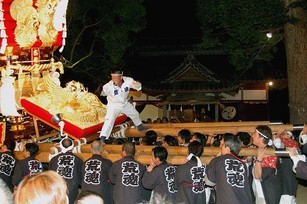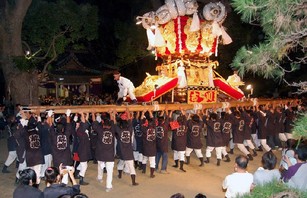The Aki Matsuri in a small town
Festival. I live in a rural part of
Kanonji, away from the main downtown area.
The district is called Furukawa-Cho.
In Kanonji, a lot of the districts near the city center will have their
festival on the same day, later in the month of October.
We are so far away, though, so we regularly have our festival on the Sports Day holiday, the first 3-day weekend of the month.
This year was like most others, everyone got together for a few short Sunday morning meetings leading up to the event. Then, on the weekend just prior to the festival, a lot of the citizens, mostly men, got together to actually open the storage room and put together the floats that they would push around all of the streets of our district for 2 whole days.
The cost of these floats is almost equivalent to a house. They are finely crafted, and built with great care and precision. Families from our district donate a large amount of money to see that they are built, and pay for storage facilities to maintain them. When I learned that my in-laws paid so much money to help make this event happen, I was surprised at first. But, it took only one festival to see how important this is to everyone. Those people who contributed to the float, called a chosa, are given a happi coat that allows them the right to participate in the festival every year. Without the happi coat, you cannot be one of the people that pushes and pulls the chosa around the neighborhood. Still, they allow people to rent the happi coats for a few thousand yen if they want to help out. There is always the need for more volunteers.
The festival in Furukawa-Cho began on the Sunday morning. Many of the local young people got together and started pushing the float around the district. A few of the students-aged kids sat in the middle and beat on the drum as individuals led the helpers in chants that followed the beat of the Taiko drum. They did this all day. They took breaks to drink or chat. Some of the ladies, mostly housewives, in the community volunteered to help prepare meals, and really everyone took part. Families hanged large paper lanterns outside of the doorways, and members went around to collect a small amount of money to help pay for some of the expenses of the two days.
Everything culminated at the small shrine
in the center of our district on the final night. Everyone came together. There were babies of only a few months and
there were the elderly in their 80’s or 90’s.
They first watched a small show of taiko drummers perform right in front
of the shrine. This was followed by many
men and women using all of their strength to lift the extremely heavy chosa above their heads in a display of
their strength. As they did this, all of
the onlookers cheered and praised them.
There was indeed a sense of pride of living in this small rural area of
Kagawa. People were all smiles at this
event, and you could actually feel their pride to be a member of this small
community. And, as the main event ended,
many people followed the chosa around
the neighborhood for one last show of the year.
Then, the extremely tired crew of helpers pushed the chosa back to its storage shed, took it
apart and placed all of the pieces in their proper place where they will rest
for a whole year, to be pulled out for two glorious days next fall.

